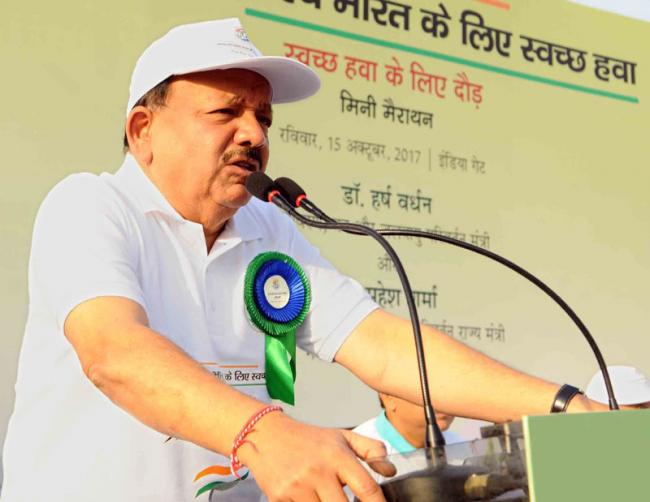
Air quality in Delhi better compared to last year: Harsh Vardhan
Speaking to a media agency here today, the Minister said that the number of ‘Good’, ‘Satisfactory’ and ‘Moderate’ days has increased and ‘Poor’ and ‘Very Poor’ category has reduced significantly compared to 2016.
Emphasising the need to build a social movement to combat pollution,Harsh Vardhan has appealed to the citizens to individually and collectively, undertake one good, green deed every day.
The Minister also said that he has held meetings with officers from the states of National Capital Region (NCR) on stubble burning.
He added that efforts are being made to provide farmers with an alternative to burning, so that farmers can create wealth from waste.
Harsh Vardhan also reiterated that scientists have been asked to develop zero pollution crackers to tackle pollution.
The year 2017 has seen positive changes with respect to air pollution in Delhi due to a number of steps taken by Union Government, State Governments and Government of Delhi. The Centre has been closely involved in management of air pollution in Delhi and NCR, besides other cities in the country.
A comparison of the air quality until this period with last year shows positive changes in air quality levels.
The year 2017 has seen few ‘Good’ days (AQI <50) this year unlike last year, when there were no ‘Good’ days. Number of ‘Satisfactory’ days (AQI between 51 and 100) up to October 19 has nearly doubled. The number of ‘Moderate’ days (AQI between 101 and 200) has increased by nearly 22%. Number of ‘Poor’ days has nearly declined by 10% (AQI between 201 and 300). The number of ‘Very Poor’ days has declined by nearly 30% (AQI between 301 and 400). There has been no ‘Severe’ day (AQI >400) in 2017, as against 7 during the same period in 2016. The air quality has been significantly better this year than last year during Diwali. AQI on Diwali and post-Diwali day was 426 and 425, respectively last year and it has been 326 and 367 this year. Also, there has neither been smog, as was the case last year post-Diwali, nor has there been an Emergency-plus situation.
A number of other measures have been taken to improve air quality in the Delhi NCR region.
These include control and mitigation measures related to vehicular emissions, re-suspension of road dust and other fugitive emissions, bio-mass/municipal solid waste burning, industrial pollution, construction and demolition activities and installation of online continuous (24X7) monitoring devices by major industries.
The Union Government is working closely with State Governments, CPCB, SPCBs and EPCA. Government has notified Graded Response Action Plan (GRAP) for control of air pollution. CPCB has also issued a comprehensive 42 point action plan to mitigate air pollution.
In order to involve people in the effort, Government had launched a campaign called ‘Harit Diwali and Swasth Diwali’ involving over 2000 schools in Delhi and over two lakh schools in the country.
The Government had also organised a Mini-Marathon for‘SwachhHawa for Swachh and Swasth Bharat’ on October 15, 2017 at India Gate, in which nearly 15,000 school children participated.
All stakeholders including State Governments and general public specially school children, who have been at the forefront of the campaign for clean air, have made a significant contribution, resulting in the positive changes. The Government will continue to work with all the stakeholders to ensure better air quality.
Support Our Journalism
We cannot do without you.. your contribution supports unbiased journalism
IBNS is not driven by any ism- not wokeism, not racism, not skewed secularism, not hyper right-wing or left liberal ideals, nor by any hardline religious beliefs or hyper nationalism. We want to serve you good old objective news, as they are. We do not judge or preach. We let people decide for themselves. We only try to present factual and well-sourced news.







